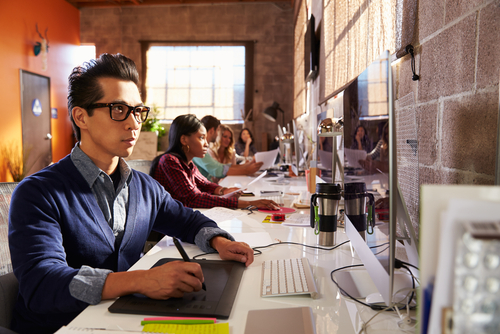5 Tips For Working With Other Graphic Designers
Graphic designers excel at providing logos, artworks and designs that captivate the public. Besides looking great, graphic designs must also exemplify client sensibilities and values. In many cases, this requires collaboration between two or more graphic designers. Here are a few common-sense guidelines that can make this collaboration much easier:
Be Specific
Specificity is key when informing your fellow graphic designers about your needs and requirements. Especially if you are a manager or team leader, it is important to give collaborators specific time frames and specific goals. It is a time-tested truism that overly broad goals greatly increase one’s chances of overreaching and experiencing project failure. All team members should feel free to express their personal benchmarks for success in order to maintain continuity of group intention and purpose.
Stay Positive When Discussing Incomplete First Drafts
Almost always, the collaborative process requires plenty of patience. As with other types of designs, graphic designs can require multiple drafts in order to meet quality requirements. Even if the first draft has serious drawbacks, maintain a positive and professional attitude. Most graphic designers respond to respectful treatment with willingness to work hard to perform necessary changes. Remember that the first draft is a starting point for a fruitful collaboration, not an end point. When giving graphic designers feedback on their work, try to avoid overly generalized feedback. Even outstanding designers may have difficulties working with general statements like “it needs to pop out more” or “make it more striking.”
Ask More Questions
When you’re confused about aspects of particular design or project, it is all too easy to become frustrated and contentious. Asking questions is a great way to clear up misunderstandings with other graphic designers. Lack of understanding is what causes minor roadblocks to look like massive, game-changing problems. Remember that graphic designers are “creative types” with expansive visions. Oftentimes, a designers’ visions can outstrip their abilities to clearly explain their reasons for various design choices.
Don’t Be Overly Controlling
Whether you are a project head or simply a team member, it’s only natural to be passionate about your graphic design ideas. After all, most professionals in this field strive for absolute excellence. Nevertheless, working with another graphic designer requires that you demonstrate the spirit of compromise. Collaborative design necessarily involves a give-and-take negotiation between two or more separate design visions. Even if your collaborator is an outstanding designer, it is unlikely that you and your collaborator will agree on every decision. While keeping core quality requirements firmly in place, allow some wiggle room to ensure a more fruitful collaboration.
Know When It’s Time To Say Goodbye
Segueing directly from the last item, remember that there is almost no end to the number of changes and adjustments you can make to a design. One way to ruin professional relationships with graphic designers is to demand endless improvements. Clients give designers enough difficulties in this regard, designers shouldn’t have to accept this behavior from fellow designers. Recognize that it is impossible to make any design absolutely perfect. Even if you can recognize a definite need for improvement, conduct a cost-benefit analysis to see if making the improvement is worth wasting time and fraying team spirit.
Concluding Thoughts
Remember that these guidelines represent the tip of the iceberg when it comes to dealing with problems that arise during graphic design collaborations. In any type of professional collaboration, willingness to improvise is important to overcome unforeseen problems. As long as you maintain a spirit of professionalism and respect, you will likely be able to handle any issue that comes your way.
Related Resources:
